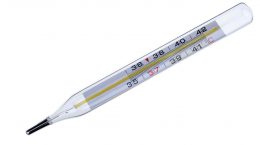Published on May 31, 2019
Levels of mercury in the blood are tested as part of the Magnesium plus Elements blood spot test, now offered by GrassrootsHealth. Mercury is one of the most toxic heavy metals – you can learn more about mercury’s adverse health effects in a previous blog. The dried blood spot test is an indicator of recent exposure to organic mercury (methylmercury or ethylmercury), which has a half-life of around 70 days in the blood.
The whole blood reference range for mercury of the average population is less than 5.29 micrograms per liter (μg/L), however, no amount of mercury is considered safe.
Other types of mercury include elemental mercury (found in batteries, thermometers, and dental amalgams), and inorganic mercury (found in mercuric chloride and skin-lightening creams). While these types of mercury may have a slight effect on the blood spot test result, a urine test is a better indicator of exposure to these specific types of mercury.
Where does organic mercury come from?
 While some people are exposed to mercury as an occupational hazard, most mercury exposure is due to consumption of fish and shellfish that contain methylmercury. About 95% of organic mercury that is ingested is absorbed into the fatty tissues of the body, and can be measured via blood spot testing.
While some people are exposed to mercury as an occupational hazard, most mercury exposure is due to consumption of fish and shellfish that contain methylmercury. About 95% of organic mercury that is ingested is absorbed into the fatty tissues of the body, and can be measured via blood spot testing.
Types of fish with the highest mercury concentrations include king mackerel, shark, swordfish, and tuna. A complete list of mercury levels in different types of fish and shellfish can be found here.
Organic mercury in the form of ethylmercury can also come from multi-dose preparations of vaccines containing the preservative thimerosal, such as some flu vaccinations. This form of mercury is also measured by blood spot.
What can you do if your blood spot mercury result is high?
 After looking at the sources of mercury mentioned above, you might be able to figure out where the mercury is coming from so you can take steps to decrease exposure. For example, the high mercury result could be related to a fish oil supplement (one that has not been molecularly distilled or vigorously tested for heavy metals), or it could have come from a “one time” source, such as a flu vaccine within a few days prior to the test, or a meal of sushi or fish high in mercury the night before. If you suspect the mercury is coming from a supplement, you could change products, or go off it for 30 days and then retest for mercury. The test should be taken at least 48-72 hours after eating high mercury foods.
After looking at the sources of mercury mentioned above, you might be able to figure out where the mercury is coming from so you can take steps to decrease exposure. For example, the high mercury result could be related to a fish oil supplement (one that has not been molecularly distilled or vigorously tested for heavy metals), or it could have come from a “one time” source, such as a flu vaccine within a few days prior to the test, or a meal of sushi or fish high in mercury the night before. If you suspect the mercury is coming from a supplement, you could change products, or go off it for 30 days and then retest for mercury. The test should be taken at least 48-72 hours after eating high mercury foods.
In addition to identifying sources of mercury, being aware of selenium status is also useful. Selenium can help protect against mercury toxicity by binding to mercury and reducing its bioavailability, so it is important to make sure selenium levels are within a healthy range, especially with a high mercury level. A measurement of selenium is included in the Magnesium plus Elements panel – you can learn more about selenium here.
Methods of detoxing or chelation for mercury are available, however, it is best undertaken with the help of a doctor who is familiar with the process, as it does have some risks. A good place to begin looking for a qualified practitioner is the American College for Advancement in Medicine (ACAM).
What types of mercury will not be measured by the blood spot test?
The dried blood spot test for mercury will include minimal amounts of elemental mercury from sources such as dental amalgams, mercury thermometers, and fluorescent light bulbs. It will not include inorganic forms of mercury, nor will it show the amount of kidney burden from such types of mercury. As mentioned previously, a urine test is a better indicator of levels of these types of mercury.
Are you aware of how much mercury is in your blood?
Make sure you know your level of mercury and are taking steps to reduce or eliminate it as needed. Find out your levels today! Log on to the shop to get your tests and see for yourself if your levels can be improved.
How can you track my mercury levels and intake of high mercury fish?
To help you track your intake of high mercury fish along with your resulting mercury levels, GrassrootsHealth has created an online tracking system called myData-myAnswers. You can track any of your supplemental and dietary nutrient intakes to see how they impact your levels and overall health. Check it out today!






